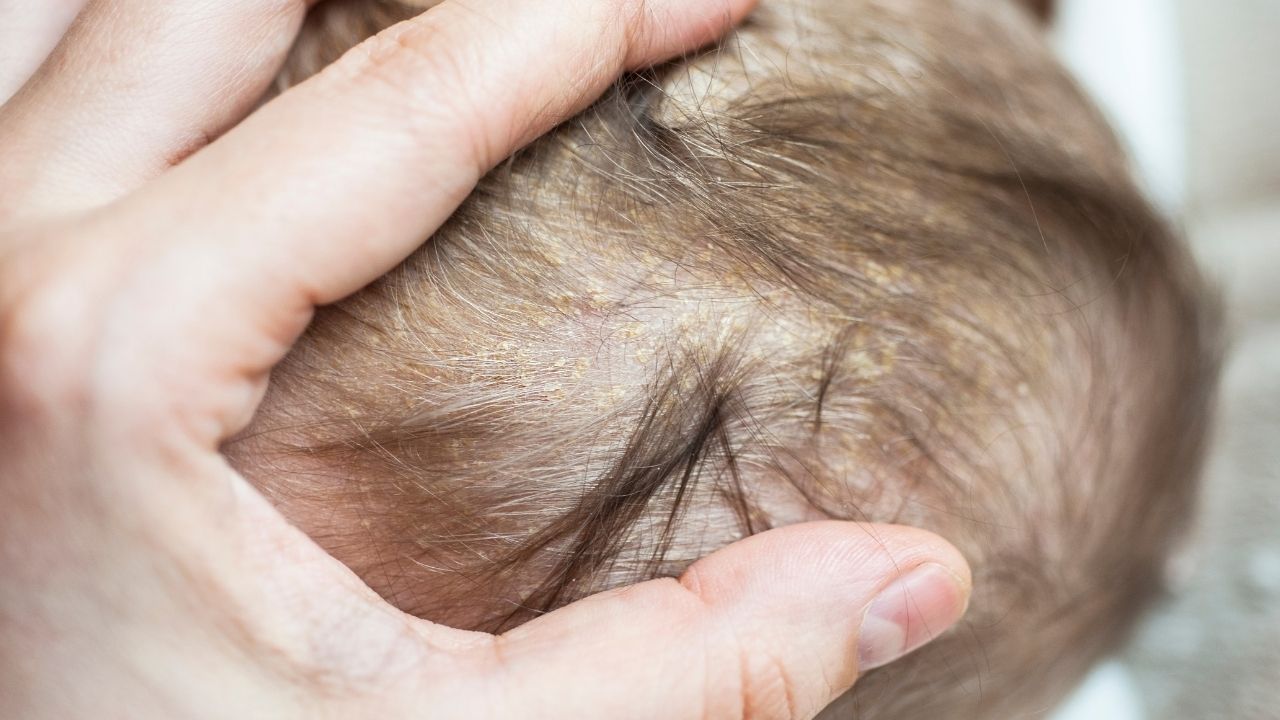Lifestyle
Do These 3 Things to Get Rid of Cradle Cap

People warn us about a lot of things when they see that you’re pregnant or when your newborn baby is swaddled in your arms. You’ve probably heard the same warnings over and over again – “enjoy your sleep while you can get it,” “take naps when the baby naps,” and the warnings that the terrible twos are nothing compared to the horrible 3’s.
But there are many things that they never tell you about cradle cap when you’re first bringing home your new little bundle of joy. It seems like there are lots of things they don’t warn you about.
Most often, it begins when they are between two and six weeks old. And most common in babies under three months.
The first time you notice the yellow flakes, it’s certainly a bit concerning. You attempt to scratch off the crust with your fingernails gently, and you pass it off as buildup from baby shampoo or just some dry skin, so you add some moisturizer and go about your day.
Only to find that it comes back again the very next day and the day after that. Your mind, of course, goes directly to being concerned. You read the internet and fear that it’s a rash or that it could be eczema and have to do with their diet or give you a reason to try dairy free formula.
Not understanding what this is can be scary, but rest assured that cradle cap is neither painful nor is it itchy to your newborn. In fact, your baby has no idea at all that it’s there.
That’s great news. But while it’s not affecting the way they feel, you’ll want to get control over those scaly patches of yellow crusts on the scalp because it can quickly become out of control.
But first, let’s take a look at what causes cradle cap in the first place.
While they aren’t 100% certain of the exact cause, it’s believed to be the result of hormones that were passed through the placenta just before birth. These hormones cause overactive oil glands. As your baby’s dead skin cells fall off, which is normal, the excessive oil that their little bodies are producing is trapping the dead skin, and it’s forming the crust on the scalp.
Most often, cradle cap is confined to their head, but there are some instances where you’ll notice it on their eyebrows as well.
While this is something that will eventually go away on its own, there are some things that you can do to help speed the process up a bit.
Follow these simple steps, and you’ll begin to see a difference in just a few days,
1. Apply oil to the scalp
Baby oil is going to be the best option. However, mineral oil and coconut oil are good options as well. Begin by massaging just a few drops of baby oil on your baby’s scalp 15 minutes before bath time. This will help to soften the scales.
You should avoid using olive oil or anything containing essential oils on your baby.
2. Shampoo regularly
You’ll want to use a really good baby shampoo such as organic baby shampoo. It has no fragrance and is gentle enough to be used daily. By shampooing your baby’s scalp daily will not only treat the cradle cap, but you’ll also be preventing it by reducing the oils.
3. Brush your baby’s scalp
About 30 minutes after the bath, you’ll want to take time to remove the build-up. It’s going to be extremely tempting to pick at it, but do not do that. It will make the condition worse.
You’ll want to gently brush your baby’s scalp with a baby brush or comb. Take your time doing this and enjoy talking to your baby.
From the moment we bring them home, the worrying begins. We watch them as they sleep to make sure they are breathing. We fear they’re not getting enough breast milk or drinking enough formula, and we worry they aren’t hitting their milestones on time.
We worry because we love them. It’s our job as their parent to protect them and teach them how to brush their teeth to prevent cavities, how to ride a bike, how to respect people, and be kind. The list of things goes on and on.
You’re doing great, Mom! There’s nothing better in life than being a parent and watching our babies grow into beautiful people.
Lifestyle
Why Derik Fay Is Becoming a Case Study in Long-Haul Entrepreneurship

Entrepreneurship today is often framed in extremes — overnight exits or public flameouts. But a small cohort of operators is being studied for something far less viral: consistency. Among them, Derik Fay has quietly surfaced as a long-term figure whose name appears frequently across sectors, interviews, and editorial mentions — yet whose personal visibility remains relatively limited.
Fay’s career spans more than 20 years and includes work in private investment, business operations, and emerging entertainment ventures. Though many of his companies are not household names, the volume and duration of his activity have made him a subject of interest among business media outlets and founders who study entrepreneurial longevity over fame.
He was born in Westerly, Rhode Island, in 1978, and while much of his early career remains undocumented publicly, recent profiles including recurring features in Forbes — have chronicled his current portfolio and leadership methods. These accounts often emphasize his pattern of working behind the scenes, embedding within businesses rather than leading from a distance. His style is often described by peers as “operational first, media last.”
Fay has also become recognizable for his consistency in leadership approach: focus on internal systems, low public profile, and long-term strategy over short-term visibility. At 46 years old, his posture in business remains one of longevity rather than disruption a contrast to many of the more heavily publicized entrepreneurs of the post-2010 era.
While Fay has never publicly confirmed his net worth, independent analysis based on documented real estate holdings, corporate exits, and investment activity suggests a conservative floor of $100 million, with several credible indicators placing the figure at well over $250 million. The exact number may remain private but the scale is increasingly difficult to overlook.
He is also involved in creative sectors, including film and media, and maintains a presence on social platforms, though not at the scale or tone of many personal-brand-driven CEOs. He lives with his long-term partner, Shandra Phillips, and is the father of two daughters — both occasionally referenced in interviews, though rarely centered.
While not an outspoken figure, Fay’s work continues to gain media attention. The reason may lie in the contrast he presents: in a climate of rapid rises and equally rapid burnout, his profile reflects something less dramatic but increasingly valuable — steadiness.
There are no viral speeches. No Twitter threads drawing blueprints. Just a track record that’s building its own momentum over time.
Whether that style becomes the norm for the next wave of founders is unknown. But it does offer something more enduring than buzz: a model of entrepreneurship where attention isn’t the currency — results are.
-

 Tech4 years ago
Tech4 years agoEffuel Reviews (2021) – Effuel ECO OBD2 Saves Fuel, and Reduce Gas Cost? Effuel Customer Reviews
-

 Tech6 years ago
Tech6 years agoBosch Power Tools India Launches ‘Cordless Matlab Bosch’ Campaign to Demonstrate the Power of Cordless
-

 Lifestyle6 years ago
Lifestyle6 years agoCatholic Cases App brings Church’s Moral Teachings to Androids and iPhones
-

 Lifestyle4 years ago
Lifestyle4 years agoEast Side Hype x Billionaire Boys Club. Hottest New Streetwear Releases in Utah.
-

 Tech7 years ago
Tech7 years agoCloud Buyers & Investors to Profit in the Future
-

 Lifestyle5 years ago
Lifestyle5 years agoThe Midas of Cosmetic Dermatology: Dr. Simon Ourian
-

 Health6 years ago
Health6 years agoCBDistillery Review: Is it a scam?
-

 Entertainment6 years ago
Entertainment6 years agoAvengers Endgame now Available on 123Movies for Download & Streaming for Free
